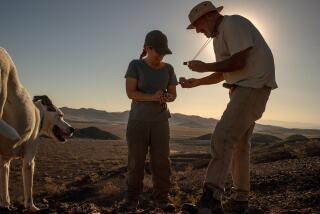Environmental Battle on Australian Hill
- Share via
DARWIN, Australia — A scrub-covered hill sitting on rich seams of gold, platinum and palladium has become a battleground for Australia’s mining interests and environmentalists.
To the mining industry, the hill south of Darwin in the Northern Territory has the potential to earn millions of dollars for the country.
Environmentalists say its position in the unspoiled wilderness of Kakadu National Park, made famous by the film “Crocodile Dundee,” should prohibit mining at any cost.
The fate of Coronation Hill is likely to show how far Australia is prepared to sacrifice wealth for a protected environment.
It has become the thorniest problem for the Labor Party government, which won an election in March thanks to the support of “green” voters, and is now agonizing over the form of its “ecologically sustainable development” policy.
“For the mining industry, Coronation Hill is an icon. If they can knock down that icon, they will have open house in all national parks,” said one environmentalist.
The government has appointed a Resource Assessment Commission to rule on whether Coronation Hill should be mined.
Battlelines between the mining industry and environmentalists are uncompromising.
The commission also has to take into account the sensitivities of local Aborigines.
The Jawoyn people consider the hill, which they call “Guratba,” an important sacred site in what they call the Sickness Country. The rugged features of the area are believed to have been created by the mystical being “Bula” in prehistoric times.
Both environmentalists and The Broken Hill Minerals Co., which holds the site’s mining lease, know that Jawoyn support could swing the commission’s decision.
Broken Hill, Australia’s largest company, says it believes most of the 400 Jawoyn “are not opposed to mining at Coronation Hill.”
The relative importance of the mine is also in dispute.
Broken Hill, which spent $9 million exploring the site, says Coronation Hill contains a proven 650,000 ounces of gold, 100,000 ounces of palladium and 30,000 ounces of platinum, making it the only mine in the world where all three metals exist in commercial quantities.
Conservationists believe the mine is not a cornucopia of minerals and is not worth the potential damage it could inflict on Kakadu park.
Mining at the hill would be concentrated on a slope bordering the South Alligator River, the main water artery of Kakadu.
“The chances of water pollution from the mine or the tailings dam are just too high,” Darwin environmentalist David Cooper said.
The area, including Coronation Hill, was mined extensively about 20 years ago for uranium and tin.
A Broken Hill environmental impact study showed a new mine would have no impact on the area surrounding Coronation Hill, which lies in stage three of the Kakadu park. Stages one and two already have World Heritage listing for their beauty.
Cooper believes the government’s decision last October to cut by 98% the area in stage three zoned for possible mineral exploration could prove vital.
“That decision focused discussion on Coronation Hill, which is only a medium-sized deposit, so they cannot claim mining should be allowed for the national interest,” he said.
In 1986, the government had defined a large conservation zone in Kakadu where exploration was allowed for five years.
But in October, facing a tight election, the government reduced the zone to an area surrounding Coronation Hill, drawing howls of protest from the mining industry and applause from the conservation lobby.
“The decision to reduce the exploration zone . . . will lock away up to seven billion (Australian) dollars ($5.25 billion U.S.) of resources which Australia can ill afford,” Broken Hill said then.
Both sides are now preparing submissions for the commission. They agree that the problem will not be resolved for both sides.
“It is still going to be a win-lose decision,” Cooper said. “And one side is going to be very unhappy.”
More to Read
Sign up for Essential California
The most important California stories and recommendations in your inbox every morning.
You may occasionally receive promotional content from the Los Angeles Times.













